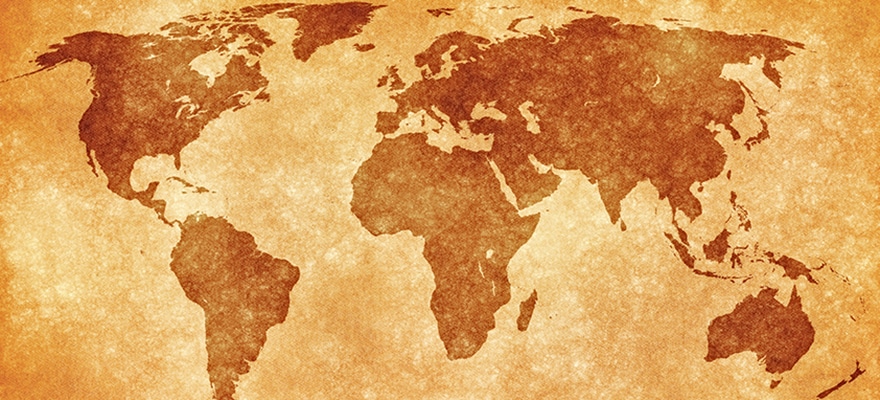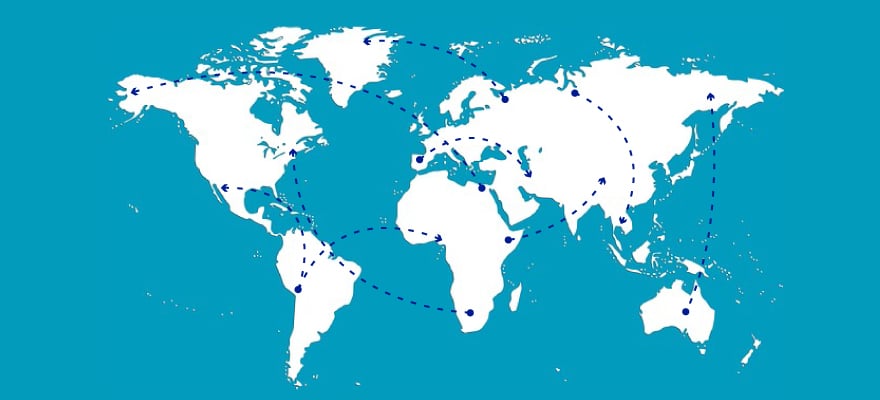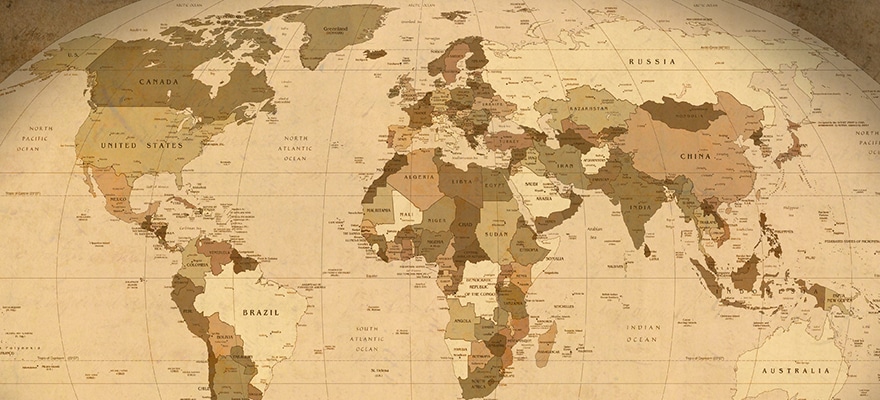In war the US has learned, in part from the Israelis, the concept of hitting the enemy with air assets some 20 miles forward of the forward edge of the battle area, before engaging with artillery and mechanized infantry. The shock and awe portion of the Gulf Wars demonstrated the effectiveness of this tactic. Force projection unfortunately has little to do with nation-building and so hitting the enemy forward had limited value as a decisive element of both of the Gulf Wars.
Join the industry leaders at the Finance Magnates London Summit, 14-15 November, 2016. Register here!
Ever since the days of Alfred Thayer Mahan, the father of US geopolitics, the projection of naval force has been a central tenet of US geopolitics and military strategy. The US pivot toward the Asia-Pacific and the build-up of forces in the South China Sea place such tactics in sharp focus.
Now force projection is undergoing a radical change. The harrowing scenes of the D-Day invasion, scenes of slaughter depicted in such films as Saving Private Ryan and The Longest Day, may no longer be part of warfare in the future. The devastation such as that wrought on US Marines at Tarawa due to miscalculation of the neap tide, will no longer occur. Marines will no longer be delivered to the beach only under the cover of naval artillery and close air support, in amphibious tractors.
They will not be transported to enemy beaches only from LSTs and LSDs stationed offshore, in amtracs. They will be brought inland by V-22 Osprey and CH-53E helicopter. They will be brought well inland of the beaches and will cause all sorts of havoc as the enemy is left to guess as to where they will land, to guess where they will have landed.
I find these new tactics intriguing for several reasons. The first of these involves the myth of naval gunfire.
US Marine Corps history and the island-hopping campaign in the Pacific during WWII, are filled with graphic examples of furious battles fought to establish the beachhead despite the most intense preceding and prolonged naval and air bombardments. Iwo Jima is such an example.
Just as we presumed that the superiority of naval forces and guns would neutralize the beaches, we will now presume that air superiority will neutralize the inland landing fields. Those of us who have relied on air support know how much it can remind one of the song from Porgy and Bess; "A Man is a Sometime Thing." I suppose that having the alternatives of projecting force inland by air as well as on the beaches, is advantageous. An enemy bristling with surface to air weapons, including shoulder-mounted ones, will present a formidable obstacle to our Ospreys and helicopters.
The presumption of close-air-support for such a mission is just that, a presumption. I pray that the delivery of Marines to the battlefield by air saves lives. We should not rely on presumptions and a wing and a prayer when the lives of our troops are at stake.
The lessons of World War II, Arnhem and a Bridge
Bridge
The bridge or liquidity bridge is an essential component for brokers that are enabling their clients to trade at interbank rates directly via a Prime Broker or a Prime-of-Prime (PoP). While market makers do not require a bridge in order to service their clients, brokers which are sending through orders to a liquidity provider or an electronic execution venue need a bridge to connect their trading platform to the interbank market.Bridges are used extensively in forex trading, specifically for Met
The bridge or liquidity bridge is an essential component for brokers that are enabling their clients to trade at interbank rates directly via a Prime Broker or a Prime-of-Prime (PoP). While market makers do not require a bridge in order to service their clients, brokers which are sending through orders to a liquidity provider or an electronic execution venue need a bridge to connect their trading platform to the interbank market.Bridges are used extensively in forex trading, specifically for Met
Read this Term Too Far, apply.
Sun Tsu said that overconfidence creates situations where you will be defeated by the unexpected.
The race between war and trade
Force projection has taken a different form and substance with the advent of the internet. The thesis that it is necessary to use military force on land, sea and air in order to gain hegemony over areas and markets of the world has proven to be flawed time and time again. Nixon had to devalue the US dollar, the currency on which the stability of the world financial system depends, since Bretton Woods in 1971. The combination of Lyndon Johnson's Great Society and the Vietnam War caused virulent inflation in the US economy. The US could not sustain both spending on weapons for an increasingly unpopular war and spending on the revival of US urban cities seething with discontent.
Despite Nixon's withdrawal from Vietnam and his course correction with the dollar, his Republican successors saw fit to repeat the same mistakes with spending on two Gulf Wars and a war in Afghanistan while largely ignoring the need to reconstitute a crumbling US infrastructure.
E-commerce as a compelling first mover advantage
Global trade is part of a protracted battle to project economic power in tandem with the projection of force by empires, tyrannies and democracies. This use of military force is what Barbara Tuchman describes as a persistent vein in the archeology of human history - the 'March of Folly'. Economic history has proven time and again that projecting both military power overseas and domestic economic power is highly inflationary and ultimately unsustainable.
Jack Kennedy said that eternal vigilance is the price of freedom. Being prepared to fight hot wars and project global economic power at the same time is a far cry from engaging in hot wars and trying to grow a vibrant and egalitarian economy, all at the same time.
The advent of e-commerce and global trade
With e-commerce, such platforms as Amazon, Uber, Walmart and Alibaba provide the US and China with a first mover advantage in the global scaling of ideas, innovations and enterprises. This global scaling by entrepreneurs and SMEs as well as MNCs makes a reality of what Eric Schmidt of Google describes as the democratization effect of the internet.
Exploiting the breach
Walmart offers 11 million items for sale on its site. Amazon sells 220 million different items on its site. Independent enterprises sell 44% of what is sold on Amazon. These platforms represent the successes, limitations and challenges for both third party sellers and the deployment of e-commerce platforms. Amazon failed to scale successfully in China as did Uber. Amazon is spending $5 billion in an effort to deploy successfully in India. Uber has met stiff competition in Southeast Asia, a market of 600 million consumers. Grab (taxi) has successfully competed against Uber in the Southeast Asian market by being sensitive and responsive to local cultural exigencies. Drucker's oft repeated warning that "culture eats strategy for breakfast" is alive and well in global markets.
Challenging all leaders
In the future, the challenges for all leaders will not be confined to the military battlefield. These challenges will increasingly confront leaders in diverse cultural and social-political markets. The lessons of the past and present will be helpful in guiding our leaders in making wiser decisions about the deployment and projection of military and economic power while creating vibrant domestic economies.
In war the US has learned, in part from the Israelis, the concept of hitting the enemy with air assets some 20 miles forward of the forward edge of the battle area, before engaging with artillery and mechanized infantry. The shock and awe portion of the Gulf Wars demonstrated the effectiveness of this tactic. Force projection unfortunately has little to do with nation-building and so hitting the enemy forward had limited value as a decisive element of both of the Gulf Wars.
Join the industry leaders at the Finance Magnates London Summit, 14-15 November, 2016. Register here!
Ever since the days of Alfred Thayer Mahan, the father of US geopolitics, the projection of naval force has been a central tenet of US geopolitics and military strategy. The US pivot toward the Asia-Pacific and the build-up of forces in the South China Sea place such tactics in sharp focus.
Now force projection is undergoing a radical change. The harrowing scenes of the D-Day invasion, scenes of slaughter depicted in such films as Saving Private Ryan and The Longest Day, may no longer be part of warfare in the future. The devastation such as that wrought on US Marines at Tarawa due to miscalculation of the neap tide, will no longer occur. Marines will no longer be delivered to the beach only under the cover of naval artillery and close air support, in amphibious tractors.
They will not be transported to enemy beaches only from LSTs and LSDs stationed offshore, in amtracs. They will be brought inland by V-22 Osprey and CH-53E helicopter. They will be brought well inland of the beaches and will cause all sorts of havoc as the enemy is left to guess as to where they will land, to guess where they will have landed.
I find these new tactics intriguing for several reasons. The first of these involves the myth of naval gunfire.
US Marine Corps history and the island-hopping campaign in the Pacific during WWII, are filled with graphic examples of furious battles fought to establish the beachhead despite the most intense preceding and prolonged naval and air bombardments. Iwo Jima is such an example.
Just as we presumed that the superiority of naval forces and guns would neutralize the beaches, we will now presume that air superiority will neutralize the inland landing fields. Those of us who have relied on air support know how much it can remind one of the song from Porgy and Bess; "A Man is a Sometime Thing." I suppose that having the alternatives of projecting force inland by air as well as on the beaches, is advantageous. An enemy bristling with surface to air weapons, including shoulder-mounted ones, will present a formidable obstacle to our Ospreys and helicopters.
The presumption of close-air-support for such a mission is just that, a presumption. I pray that the delivery of Marines to the battlefield by air saves lives. We should not rely on presumptions and a wing and a prayer when the lives of our troops are at stake.
The lessons of World War II, Arnhem and a Bridge
Bridge
The bridge or liquidity bridge is an essential component for brokers that are enabling their clients to trade at interbank rates directly via a Prime Broker or a Prime-of-Prime (PoP). While market makers do not require a bridge in order to service their clients, brokers which are sending through orders to a liquidity provider or an electronic execution venue need a bridge to connect their trading platform to the interbank market.Bridges are used extensively in forex trading, specifically for Met
The bridge or liquidity bridge is an essential component for brokers that are enabling their clients to trade at interbank rates directly via a Prime Broker or a Prime-of-Prime (PoP). While market makers do not require a bridge in order to service their clients, brokers which are sending through orders to a liquidity provider or an electronic execution venue need a bridge to connect their trading platform to the interbank market.Bridges are used extensively in forex trading, specifically for Met
Read this Term Too Far, apply.
Sun Tsu said that overconfidence creates situations where you will be defeated by the unexpected.
The race between war and trade
Force projection has taken a different form and substance with the advent of the internet. The thesis that it is necessary to use military force on land, sea and air in order to gain hegemony over areas and markets of the world has proven to be flawed time and time again. Nixon had to devalue the US dollar, the currency on which the stability of the world financial system depends, since Bretton Woods in 1971. The combination of Lyndon Johnson's Great Society and the Vietnam War caused virulent inflation in the US economy. The US could not sustain both spending on weapons for an increasingly unpopular war and spending on the revival of US urban cities seething with discontent.
Despite Nixon's withdrawal from Vietnam and his course correction with the dollar, his Republican successors saw fit to repeat the same mistakes with spending on two Gulf Wars and a war in Afghanistan while largely ignoring the need to reconstitute a crumbling US infrastructure.
E-commerce as a compelling first mover advantage
Global trade is part of a protracted battle to project economic power in tandem with the projection of force by empires, tyrannies and democracies. This use of military force is what Barbara Tuchman describes as a persistent vein in the archeology of human history - the 'March of Folly'. Economic history has proven time and again that projecting both military power overseas and domestic economic power is highly inflationary and ultimately unsustainable.
Jack Kennedy said that eternal vigilance is the price of freedom. Being prepared to fight hot wars and project global economic power at the same time is a far cry from engaging in hot wars and trying to grow a vibrant and egalitarian economy, all at the same time.
The advent of e-commerce and global trade
With e-commerce, such platforms as Amazon, Uber, Walmart and Alibaba provide the US and China with a first mover advantage in the global scaling of ideas, innovations and enterprises. This global scaling by entrepreneurs and SMEs as well as MNCs makes a reality of what Eric Schmidt of Google describes as the democratization effect of the internet.
Exploiting the breach
Walmart offers 11 million items for sale on its site. Amazon sells 220 million different items on its site. Independent enterprises sell 44% of what is sold on Amazon. These platforms represent the successes, limitations and challenges for both third party sellers and the deployment of e-commerce platforms. Amazon failed to scale successfully in China as did Uber. Amazon is spending $5 billion in an effort to deploy successfully in India. Uber has met stiff competition in Southeast Asia, a market of 600 million consumers. Grab (taxi) has successfully competed against Uber in the Southeast Asian market by being sensitive and responsive to local cultural exigencies. Drucker's oft repeated warning that "culture eats strategy for breakfast" is alive and well in global markets.
Challenging all leaders
In the future, the challenges for all leaders will not be confined to the military battlefield. These challenges will increasingly confront leaders in diverse cultural and social-political markets. The lessons of the past and present will be helpful in guiding our leaders in making wiser decisions about the deployment and projection of military and economic power while creating vibrant domestic economies.






















